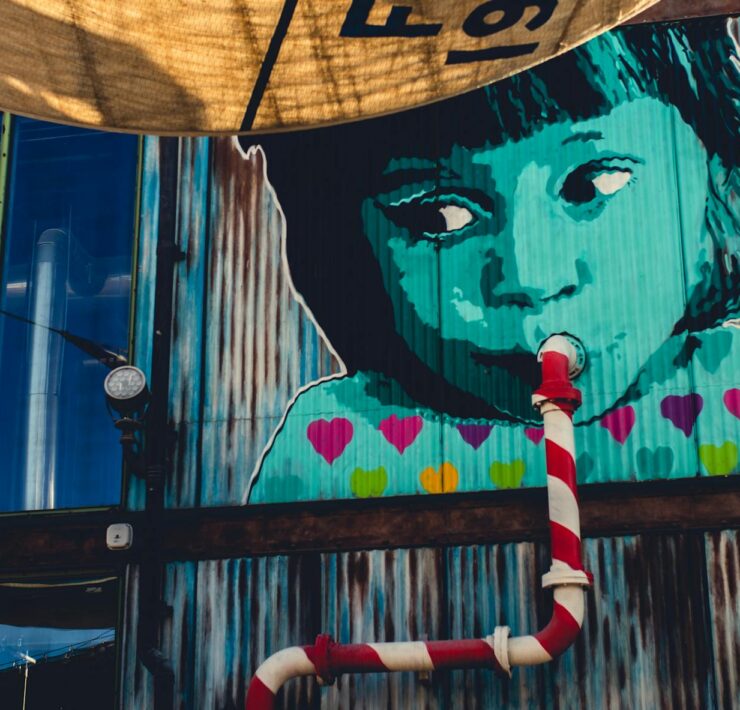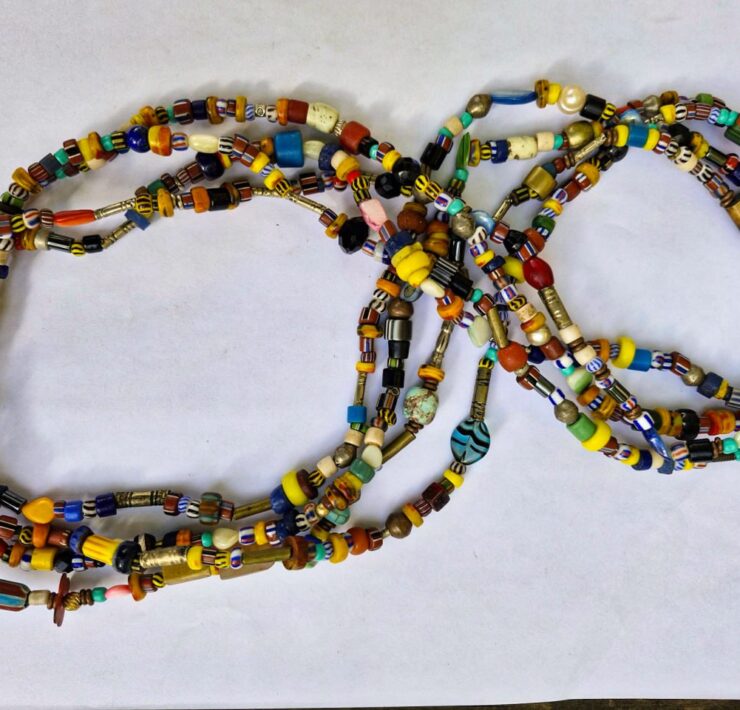Plastic Art Explores the Issue of Managing Waste

Mr. Wanyama Ogutu is a scholar in the Master of…
I encountered my first experience with flying latrines on top of my oxidized mabati (iron sheet) house years ago in the Eastlands of Nairobi. Every morning at 5 a.m., I would watch my neighbors’ children relieve themselves in a plastic bag and then throw the bag away in any direction. My landlord had only constructed one latrine that was 200 meters away near the famous Nairobi River, and the latrine was too busy during daybreak hours. The plastic art reminded me of my deplorable life in the Mathare slum. I live 100 meters away from a stinking garbage heap near St. Christopher’s ACK Church, where I have been casting my vote since 1992 in favor of His Excellency, Rt. Hon. Eng., Raila Odinga. Next to that election polling station was a big land of plastic garbage and sewage leading to the Nairobi River. The oink noises of pigs and piglets, the clucking sound of hens, and the baa cries of goats were heard throughout midnight from the stinking garbage land. The chorus of school children imitating Miss Wailimo, the teacher, was normal during the week at Gorofa Ya Juu Primary School. I missed my neighbor’s church and a loudspeaker just next to my door every Friday night. He babbled with prayer, chanting, “Jehoba Niso!” “Jehoba Jile!”. On Saturday, the one-eyed man never failed to make noise after taking puffs of Jaba (bhang)and sips of “chang’aa’ (illicit liquor) “ at the next rusty bar near Gorofa Ya Juu primary school. On Sunday, a mixture of churchgoers took over the atmosphere at the same Gorofa Ya Juu primary school with the noises of the gods of their tribe. I used to see dreadful small boys and girls, men and women, searching for garbage while making a loud, sexy noise of laughter. Some even constructed a shelter with plastic bags, and they were living as families. Fighting and chaos never failed to erupt among themselves, and only police near Huruma Station could make them settle down. That is how the plastic art depicted the true-life story of Nairobi’s low-income dwellers.

The last time I heard a census count from the Kenya National Bureau of Statistics (KNBS), I had secured a job as a teacher at a low-income school in Buru Buru. To flee the invasion of rats, I took refuge in the Githurai area because I also had long to ride on Mbogi (a local commuter train) snaking to Ruiru. During that period, I heard that the President of the Republic of Kenya was releasing the KNBS 2019 census, so I became curious and stuck my ear to the Kabambe radio for a whole week. It did not shock me that Nairobi had approximately three to four million residents, and Mathare, my former home, was ranked among the highest-populated areas with the most deplorable lifestyle quality. The high population was contributed to by a high rate of fertility among low-income families and rural-urban immigration, hence extracting a large amount of waste garbage. Before the ban on plastic bags, the Kenyan government had announced that plastic waste was causing an unhealthy lifestyle. Japan, India, South Africa, and Nigeria are facing the same challenges as Nairobi. According to a BBC Africa edition report, plastic garbage increases daily with the increase in population in urban cities in Africa. One night, I listened to my county government official on a radio talk show, and he said that waste garbage in the city of Nairobi contributes to about 3,000 tons of garbage waste per day. However, he failed to justify why low-income areas of Mathare, Kariobangi, and Dandora in Nairobi were used as dumping sites.
The United Nations (UN) on climate change has recognized the issue of plastic waste disposal as a serious environmental problem in major cities in Africa. They have stated that over 100 million metric tons of plastic need to be dealt with by the year 2040, particularly in Nairobi City County. Mr. Moussa Faki Mahamat, an outgoing chairman of the Africa Union, has encouraged various countries to come up with creative strategies that would address the challenges of climate change. In his State of the Union address at the Capitol in Washington, D.C., former President Barack Obama of the United States once said that no problem threatens the current generation more than the challenges of climate change. The President of Rwanda, Paul Kagame, has gone on to institute laws forbidding the use of plastic. He went further and initiated a clean-up program for the public to make Rwanda a green country. Similarly, Kenyan law has gone ahead and banned the use of single-use plastic through Kenya Gazette Notice No. 2356. The National Environment Management Authority (NEMA) went on to give an alternative option of carrier bags. During this period, I recall that the streets of Mathare were filled with female hawkers selling reusable bags, and plain cloth askaris and kanjos were roaming around, taking bribes from anyone found with a Jawala (polythene bag). NEMA cautioned the general public on the radio that reusable bags were more hygienic and durable compared to Jawala on top of my mabati house. I increased the volume of my small radio so that my neighbor would hear it.

The United Nations Environmental Programme (UNEP) has laid out a roadmap to dramatically reduce the risks of plastic waste in the environment. The road map is absolutely keeping plastic waste out of ecosystems. The UNEP vision plan wants to end plastic pollution and create a healthier environment that is friendly to human beings. In 1977, Professor Wangari Maathai founded the Green Belt Movement (GBM) under the auspices of the National Council of Women of Kenya (NCWK). It is responding to conserve natural resources and protect the environment. The initiative has inspired the educational system in Kenya and organizations to preserve and protect ecosystems through the government’s constitutions and county government by-laws. Other environmental groups, such as Green Anglican, are also protecting the environment through their various church programs. The Green Belt Movement (GBM) initiative led by Professor Wangari Maathai won the Nobel Prize for championing better management of the environment, and waste management, including recycling, reusing waste, and a clean environment, among other things. Scholars at university conferences and seminars are discussing the importance of managing plastic waste through creative art activities. They acknowledge that creative art addresses the challenges of climate change in urban cities in Africa. They note the need to use environmentally friendly materials to create a healthier environment. I have noticed that many organizations and individuals are recycling plastic waste through creative art and creating artwork that depicts the challenges of climate change. This effort has inspired artists to be creative and solve their environmental problems. It is also educating society to live in a healthier environment. Several artists have been celebrated for utilizing eco-friendly art, including Rosemary Karuga. She used Rexona and Unga packaging papers to create masterpieces. Her inspiration for using Unga packaging offered an opportunity to recycle and create art pieces. She turned biodegradable materials into appreciated aesthetic masterpieces. In 2015, Joel Oenga was recognized for collecting plastics from the ocean and using them to make furniture in Tiwi Beach, Kwale County. Mwaura Ndekere and Patrick Esenerwa collected colored plastic around the city of Nairobi to create paintings. They intentionally recycled plastics to improve waste management in Nairobi. Like other scholars around the world, they also responded to the call from UNEP to recycle plastic as an alternative material for producing artwork. They launched a world-class exhibition at Kenyatta University featuring a series of plastic art paintings that depicted the lifestyle of Nairobi. The exhibition included pieces titled “Bus Station”, “Ng’ombe za Mtaa,” “Chokora,” and “Gorofa ya Juu Primary School,” among others.
What's Your Reaction?
Mr. Wanyama Ogutu is a scholar in the Master of Arts (Fine Arts) program at Kenyatta University. He is also a practicing visual artist specializing in drawing, painting, and sculpture within, Nairobi, Kenya. He focusing in Painting with its’ philosophy, education and extension to Africa contemporary Art. Most of his artworks focus on interaction, environment, and education. Wanyama has a passion for fine art research; its philosophy, development, and relevance. He writes on profound academic topics, where he has presented and published in international journals and conferences around the world. He is a consultant in innovation and creative strategy on issues affecting our society. He is currently a part-time teacher at some TVET institutes within Nairobi.

















